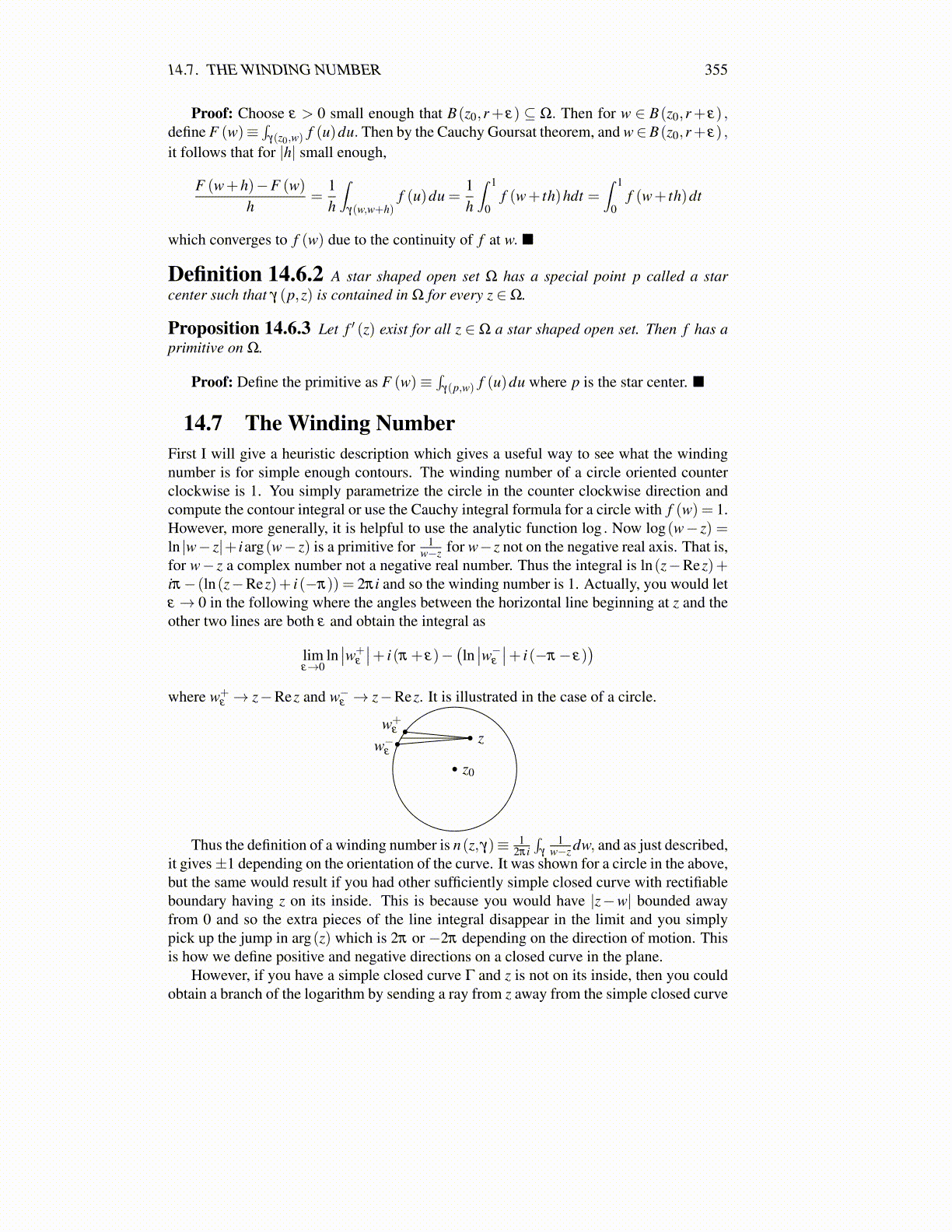
14.7. THE WINDING NUMBER 355
Proof: Choose ε > 0 small enough that B(z0,r+ ε) ⊆ Ω. Then for w ∈ B(z0,r+ ε) ,define F (w)≡
∫γ(z0,w) f (u)du. Then by the Cauchy Goursat theorem, and w∈B(z0,r+ ε) ,
it follows that for |h| small enough,
F (w+h)−F (w)h
=1h
∫γ(w,w+h)
f (u)du =1h
∫ 1
0f (w+ th)hdt =
∫ 1
0f (w+ th)dt
which converges to f (w) due to the continuity of f at w. ■
Definition 14.6.2 A star shaped open set Ω has a special point p called a starcenter such that γ (p,z) is contained in Ω for every z ∈Ω.
Proposition 14.6.3 Let f ′ (z) exist for all z ∈ Ω a star shaped open set. Then f has aprimitive on Ω.
Proof: Define the primitive as F (w)≡∫
γ(p,w) f (u)du where p is the star center. ■
14.7 The Winding NumberFirst I will give a heuristic description which gives a useful way to see what the windingnumber is for simple enough contours. The winding number of a circle oriented counterclockwise is 1. You simply parametrize the circle in the counter clockwise direction andcompute the contour integral or use the Cauchy integral formula for a circle with f (w) = 1.However, more generally, it is helpful to use the analytic function log . Now log(w− z) =ln |w− z|+ iarg(w− z) is a primitive for 1
w−z for w−z not on the negative real axis. That is,for w− z a complex number not a negative real number. Thus the integral is ln(z−Rez)+iπ− (ln(z−Rez)+ i(−π)) = 2πi and so the winding number is 1. Actually, you would letε → 0 in the following where the angles between the horizontal line beginning at z and theother two lines are both ε and obtain the integral as
limε→0
ln∣∣w+
ε
∣∣+ i(π + ε)−(ln∣∣w−ε ∣∣+ i(−π− ε)
)where w+
ε → z−Rez and w−ε → z−Rez. It is illustrated in the case of a circle.
z0
zw+
ε
w−ε
Thus the definition of a winding number is n(z,γ)≡ 12πi∫
γ1
w−z dw, and as just described,it gives±1 depending on the orientation of the curve. It was shown for a circle in the above,but the same would result if you had other sufficiently simple closed curve with rectifiableboundary having z on its inside. This is because you would have |z−w| bounded awayfrom 0 and so the extra pieces of the line integral disappear in the limit and you simplypick up the jump in arg(z) which is 2π or −2π depending on the direction of motion. Thisis how we define positive and negative directions on a closed curve in the plane.
However, if you have a simple closed curve Γ and z is not on its inside, then you couldobtain a branch of the logarithm by sending a ray from z away from the simple closed curve